- Your Online Prague Guide by locals – Follow us:
Grömling Palace (Palác Grömlingovský)

Governor’s Summer Palace (Místodržitelský letohrádek)
December 5, 2018
Hrzánský Palace
December 5, 2018Grömling Palace (Palác Grömlingovský)
This palace, built for the lawyer Karel of Grömling, was constructed on the site of several individual townhouses by the architect Josef Jäger in 1786. The building is one of the most artistically important works of Prague Rococo architecture. In 1874, a renowned café opened on the ground floor and was the gathering place for many personalities from the Czech cultural scene. Today they’d sit and have discussions over a cup of Starbucks coffee.
Contacts
- Grömling Palace (Palác Grömlingovský)
- Malostranské náměstí 5
- 118 00 Praha 1- Malá Strana
Object history
Under the dome of the St. Nicholas Church, there is a group of three houses, of which there is one that excels in graciousness – a two-storied Rococo building facing the square Malostranské náměstí with three fronts. The original palace was built by connecting five separate burgess houses. The gradual connecting thereof formed a base for the construction of the united building of the palace. In 1764 – 85, lawyer JUDr. Karel of Grömling became the owner of all those houses, and he had the palace built by architect Josef Jäger in 1786. The palace was first named after one of the original houses, At the Stone Table, yet over time, the name changed to the Grömling or Kremlink Palace after the new owner. There is a third, incomplete attic storey under the roof of the two-storied house. The palace represents one of the artistically most significant works of Prague Rococo architecture. It has its typical features, such as the portals with carved upper corners, special Rococo stucco ornaments on the sills, and Rococo decorations of the suprafenestras (rocaille, festoonery), and others. The windows are in pairs always connected via the above-window and below-window sills, and they are richly decorated. The Northern front is a little simpler in decorations than the main Eastern front; the Southern front being rather Classicist. There are still visible remains of the cellars and walls from the original Gothic and Renaissance houses (such as vaults) in the palace. On the roof of the attics floor, the palace was decorated with stone vases and sculptures with scenes from ancient mythology by Ignác František Platzer around 1787. The object dilapidated in the 2nd half of the 19th century, and it was later repaired by architect Jan Bělský. In 1939, the palace was purchased by a renowned shoe-making entrepreneur Popper for his then still under-age daughters. After the political coup in 1948, the building was acquired by the state and it was adapted to suit the needs of the National Medical Publishing House Avicena.
The ground floor of the building served public purposes already in 1740, when there was a tobacconist store selling tobacco, newspapers and refreshments. In 1874, a café was opened here named Café Radetzky. The window at the café was facing the monument of the Bohemian-born Austrian marshal Jan Josef Václav Radecký of Radeč, which was built in 1859. The monument was removed after the World War I, and the café was then renamed to Malostranská Café. It was at first still a café for the army officers, but later on, with the change of the owner, it gradually changed into a place where many personalities of the Czech cultural life liked to come. For all, we can name Jan Neruda, Ema Destinnová or Jan Zrzavý. The Malostranská Café became just as popular on the Vltava’s left bank, as the Slavie Café by the National Theatre on the right bank.
Source: https://www.prague.eu/en/object/places/1337/gromling-palace-palac-gromlingovsky



